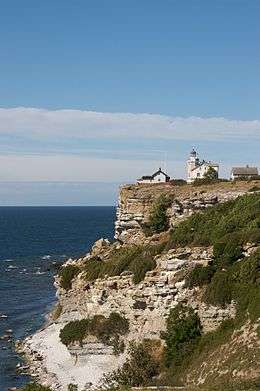Stora Karlsö
Stora Karlsö is an island off the west coast of Gotland, Sweden; part of Eksta socken. It is mostly known for its rich birdlife with large colonies of common guillemot, and flora. Stora Karlsö is a nature reserve, the second oldest in the world after Yellowstone National Park.
 Limestone cliffs and lighthouse on Stora Karlsö | |
 Stora Karlsö | |
| Geography | |
|---|---|
| Location | Baltic Sea |
| Coordinates | 57°17′1″N 17°58′19″E |
| Area | 2.5 km2 (0.97 sq mi) |
| Length | 1.5 km (0.93 mi) |
| Width | 2 km (1.2 mi) |
| Highest elevation | 52 m (171 ft) |
| Administration | |
| Additional information | |
| Official website | Welcome to Stora Karlsö |
Geography
Stora Karlsö is a small Swedish island in the Baltic Sea, situated about 6 km (3.7 mi) west of the island of Gotland. It has an area of about 2.5 km2 (0.97 sq mi) and is up to 52 m (171 ft) high. Most of the island consists of a limestone plateau, bordered by steep cliffs along the shore. It is mostly covered with alvar, with many juniper bushes and some small groves of deciduous trees.[1]
Birds and plants
The island is mostly known for its rich birdlife and flora. It has large colonies of common guillemot (about 7500 breeding pairs) and razorbill (4500 pairs). In spring, there is an extraordinary number of orchids, mostly elder-flowered orchid and early purple orchid. There are also several very rare plants for Sweden such as Adonis vernalis, Lactuca quercina (called Karlsösallat in Swedish), hart's-tongue fern and Corydalis gotlandica (the only endemic plant on Gotland).[1]
History
There is evidence that Stora Karlsö has been inhabited since the Stone Age. During the Middle Ages there was a marble quarry, which gave the material for many of Gotland's churches. The island is a nature reserve, and after Yellowstone National Park is the oldest established protected nature area in the world. From May to August there are tour boats from the village Klintehamn.[1]
The Stora Karlsö Lighthouse was built in 1887. A house for the lighthouse keeper was added in the 1930s, which resulted in the island getting its first permanent residents in modern times. Since 1974, the lighthouse is automated and there are no permanent residents on the island. The lighthouse and the surrounded buildings are now listed.[2]
Gallery
 Stora Förvar, Stora Karlsö
Stora Förvar, Stora Karlsö Stora Karlsö and Lilla Karlsö
Stora Karlsö and Lilla Karlsö Razorbills
Razorbills
See also
- Lilla Karlsö
- Svenska Turistföreningen
References
- "Stora Karlsö". www.lansstyrelsen.se. The County Administrative Boards of Gotland County. Retrieved 8 July 2015.
- "Karlsös historia". www.storakarlso.se. Stora Karlsö. Retrieved 24 April 2016.
External links

